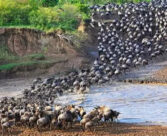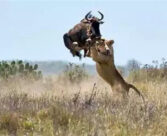From December through until April, the Serengeti’ southern plains and open woodlands around Lake Ndutu play host to an event which is widely recognized as one of the true wonders of the natural world. Here well over two million Wildebeest, Zebra and Thomson’s Gazelle congregate into vast grazing herds in order to give birth before then embarking on their never-ending journey as the seasonal rains of the region cease to fall. The special itinerary departures are carefully planned to coincide with the calving season, and our flexible program ensures close-up observations as the numerous ruminants head-out once more on their great annual migration seeking the luxury of fresh pastures anew.
top
DAY 1: Arrival Day – Arusha National Park
Your personal guide will meet you at Kilimanjaro International Airport, and then transfer to your lodgings and a tour of Arusha National Park. An ideal place for taking a day trip, its main features are the rich highland montane forest and rugged peaks of Mount Meru, coupled with the stunning Ngurdoto Crater and serene tranquility of the Momela Lakes. You can combine the safari drive with a nature walk and stroll at leisure in the fresh cool air and enjoy magnificent views over to Mount Kilimanjaro in the distance. Arusha National Park has a beguiling range of habitats that lends itself to a rich variety of wildlife including Elephant, Giraffe, Zebra, Water Buffalo, Hippopotamus, Blue Monkey, Vervet Monkey, Abyssinian Black and White Colobus Monkey, Red Forest Duiker, and the occasional Leopard may be sighted. Well over 400 bird species have been recorded here such as the colorful Toracos, Narina Trogon, Bar-Tailed Trogon, Pink Flamingo and a myriad of Eurasian migrants. Returning to your overnight lodgings you can enjoy a relaxing dinner and good nights sleep in preparation for the following morning.
Overnight stays at Lake Duluti Serena Lodge / Mount Meru Game Lodge
top
DAY 2: Lake Manyara National Park
After breakfast at your Arusha lodgings we depart for Lake Manyara National Park. The northern section of this much-coverted lakeland area is composed of volcanic rock which allows streams of clear water to flow freely out from the base of its rift wall, and as such has created a wide diversity of habitats. The park is noted for its stunning landscapes ranging from lush acacia woodlands and green dense ground-water forests through to open grassland, floodplains, swamps and lakes which supports a wealth of fauna and flora species that include Hippopotamus, Elephant, Leopard, Baboon, Ostrich, Impala, Bushbuck, Zebra, Wildebeest, Syke´s and Blue Monkey, and the most famous spectacle of all: its tree-climbing Lion. And where up in the giant towering fig and mahogany trees live family troops of Baboon. Lake Manyara´s common resident waterbirds are Spoonbill, Pelican, Heron, Hammerkop, Egyptian Goose, Cormorant and Flamingo that can be seen in their enormous pink flocks of hundreds and thousands, and creating one of East Africa’s greatest natural wonders. Popularly referred to as an ornithologist’s paradise, it is also one of the few places where you’ll be able to see both the Ground Hornbill and Crested Eagle. The game drive take place along the lake-side shore which provides incredible first-class views and great photographic opportunities of Giraffe and Buffalo in the foreground with the flat plains and flamingos on the far horizon. And it is here you can also partake and enjoy the freedom of either a guided walking safari or bicycle ride before we depart to your lodge for dinner.
Overnight stays at Lake Manyara Serena Lodge / Lake Manyara Wildlife Lodge
top
DAY 3, 4, 5 & 6: Serengeti National Park
Africa’s Premier wildlife reserve lies on a high plateau that was formed when ash blown-up from the nearby volcanoes covered the surrounding rolling landscape and which is now the natural setting for the most amazing spectacle to be found anywhere on Earth. The drive towards the park itself is nothing short of spectacular as we first pass crater highlands, stopping at the rim for a birds-eye view, before continuing-on to crest its enormous hill-side, and where spreading-out before you – as far as the eye can see – is the vast wonderland of the Serengeti savannah. Meaning “endless plains” in Swahili this unique habitat plays host to a total of around two million Wildebeest, Zebra and Thomson’s Gazelle, and where large predators populations of Lion, Leopard, Cheetah and Hyena are drawn here by the abundance of prey which seasonally migrate across this great expanse. Nearly five hundred bird species have been recorded in the area in addition to being inhabited by several resident animals that includes Baboon, Mongoose, Honey Badger, Rock Hyrax, Bat-Eared Fox, Jackal and the African Hare. On the way into the park there is the opportunity to see the famous Olduvai Gorge, where geological deposits in its deep-sided ravine revealed fossil remains of one of the earliest known specimens of the human genus, Homo Habilis, in addition to 3.5 million year-old human footprints that represent the earliest signs of mankind on the planet. After attending a short lecture describing the local geology of the gore and archeological digs, there is still ample time leftover with which to visit its small museum, before taking-in an afternoon game drive en-route to your lodge. From around January to April, the south-eastern area of rich open grassland and acacia woodland around Lake Ndutu becomes a hive of activity as numbers congregate and the calving season begins, and you will awake the following morning in the knowledge that you will spend a full day’s on the game drive, and with also the option to indulge yourself in a relaxing game walk safari where the views from the crater rim are nothing short of sheer exhilaration. On the final two days in the park you will be driven across its vast plains in search of the great migration, though it must be remembered that the actual location of this depends on the day-to-day pattern of the ruminants path which can be somewhat unpredictable. The very best way to catch the great migration is to stay in one of the Serengeti’s famous mobile camps which relocate with the movement of the herds. Regardless, you will witness that at times every ridge is just a moving mass of huge columns of advancing zebras and ungainly wildebeest with an array of predators that follow closely in unison accompanied by scores of omnipresent scavenging hyenas and vultures. There is no more thrilling way to see the magic and adventure of this African bush eco-system, and that incredible feeling of vast eternal space and shimmering fiery sunsets.
Overnight stays at Serengeti Serena Lodge / Kati Kati Tented Camp
top
DAY 7: Ngorongoro Conservation Area
Today we rise early before dawn in order to experience our last morning safari in the Serengeti park. With the rising sun over the African savannah, it is famously one of the most beautiful sites anyone can witness in life, and which additionally gains us access to observe several wildlife species at when they are more active. Afterwards, we return to your lodgings for a well-deserved late breakfast and in the afternoon proceed to the Ngorongoro Crater, which is widely-recognized as the eighth natural wonder of the world. With 600 meter high walls beneath a floor that spreads for over a hundred square miles, this truly magnificent caldera contains the greatest concentration of wildlife on the planet, and is inhabited by almost every indigenous species of wildlife known to eastern Africa. The area´s rich volcanic soils have created a varied landscape of mountain forest, extensive plains, lush grasslands, spring-sourced lakes and river swamps that are home to such diverse species as Baboon, Giraffe, Eland and Buffalo that live alongside the predator populations of Lion, Cheetah, Leopard, Hyena and Jackal, and which can all be viewed at close quarters. Ideally situated on this highland plateau, and at an altitude that is a malaria-free micro-climate, it is a place of sublime beauty so placid in nature that you can move at ease right among the animals as they come to drink, graze and wallow. The large bull elephants that reside here have extremely large tusk sets due to the rich mineral content of the volcanic soil and its grasses, and are the most incredible creatures you are ever likely to see. And indeed, the crater here is one of those rare places where there is still a good chance to observe the highly-endangered Black Rhinoceros: the great protean of all life forms that has existed on earth for millennia. In the late afternoon we then arrive to your lodge for dinner.
Overnight stays at Ngorongoro Serena Lodge / Farm of Dreams Lodge
top
DAY 8: Tarangire National Park
Very early the next morning, we again descend down to the crater floor for a final time to in one of the most incredible places on planet Earth. And after a well-deserved rest close by the lake to observe its large Hippopotamus herds, we then drive-up out of the crater and onto Tarangire National Park. The fourth largest park in Tanzania includes such diverse landscapes as grassland belts, flood plains and wooded steppes that are dominated by ancient acacia, baobab and tamarind trees. And the Tarangire River – which meanders along at its own leisurely pace – provides a permanent water source for the whole park eco-system and attracts an abundance of wildlife from Zebra, Wildebeest, Lion, Leopard, Spotted Hyena, Baboon, Waterbuck, Giraffe, Gazelle, Hartebeest, Reedbuck, Impala, Eland, Lesser and Greater Kudu, Thomson´s Gazelle, Bushbuck, Bohor Reedbuck, Fringe-Eared Oryx, Long-Necked Gerrnuk and the highly-endangered Roan Antelope. The park is also renown for having the largest elephant population in the entire country, and you will have the opportunity to observe many families at play interacting with each other and wandering majestically across the savannah plains. In addition, more than 550 species of birds have been recorded, including a large list of Eurasian migrants and resident populations of Ostrich, Bustard, Ashy Starling, Rufus-Tailed Weaver and Yellow-Collared Lovebird. After a long day of exciting game viewing we then depart to your lodge for dinner.
Overnight stays at Tarangire Simba Lodge / Tarangire Wildlife Lodge
top
DAY 9: Departure Day
On our final morning in the bush, we visit a local observatory station in Tarangire National Park where we stop and rest to watch at close-quarters various wildlife species such as Zebra and Lion drinking at the riverbank, before returning for either your awaiting hotel reservation in Arusha or onward domestic/international flight connection.
Prices: From December 1st – April 30th (excluding Christmas/New Year)
| # | 2 Persons | 3 Persons | 4 Persons | 5 Persons | 6 Persons |
| Mid-Range | $4,325 | $3,975 | $3,565 | $3,345 | $3,295 |
| Luxury | $6,725 | $6,395 | $6,015 | $5,825 | $5,745 |
Prices are based on per person and are all–inclusive.
Our Price Includes:
|
Our Price Does Not Include:
|





